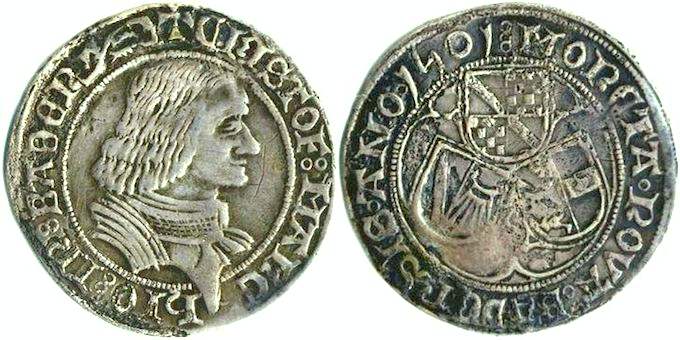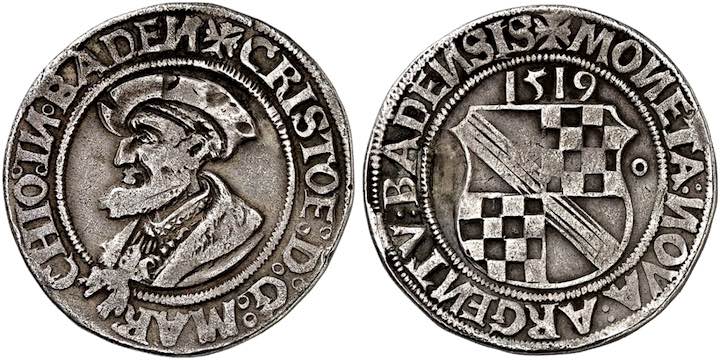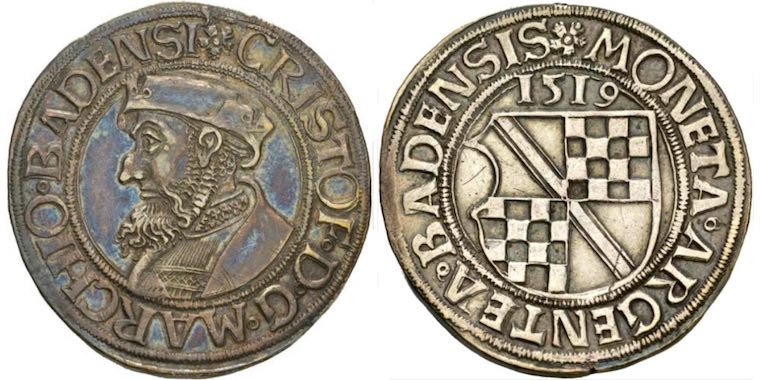|
Christoph I, Markgrave of Baden 1475-1515/27.
Christoph, born in 1453, was a loyal supporter of the Habsburgs. He helped his uncle emperor Frederic III against Charles the Bold when he besieged Neuss in 1474/45. Christoph accompanied his cousin Archduke Maximilian to Flanders when he married the beautiful Maria of Burgundy in 1477, the heiress of Charles the Bold. In the war that followed against France, Christoph supported Habsburg with his own troops. He managed to win back the city of Luxembourg. The Habsburgs thanked him with the governorship in Luxembourg and the Order of the Golden Fleece (1491). Margrave Christoph von Baden represented the emperor at his second wedding on November 30th, 1493 in the Milan Cathedral and led Bianca Maria Sforza to Innsbruck, where she had to wait 10 weeks for the emperor.
Christoph maintained good relations with his neighbors. He succeeded in territorial acquisitions. He reformed the state administration and had the castle in Baden-Baden converted into the New Palace, which became his residence in 1479.
After the margrave fell ill, he had to transfer the reign to his three sons in 1515. The following year he came under her tutelage. He died in madness in 1527 in the old Hohenbaden Castle.
After his death, his sons Bernhard, Philipp and Ernst initially shared the land. Philip died in 1533. Thus, Christoph's lands survived in the "Ernestine" (and Protestant) margraviate of Baden-Durlach and in the "Bernardine" (and Catholic) margravate of Baden-Baden. Both were only reunited in 1771.
|
|
Coin agreements between Baden and Württemberg were reached in 1475, 1478 and in the beginning of 1501. The type, fineness and quantity of the coins to be minted as well as the valuation of the jointly permitted foreign coins were regulated. 1/8 and 1/4 guldiner were planned as the largest coins.
|
 1/8 guldiner 1501, Baden Baden. Ø 25 mm, 3,70 g. Wielandt 130.
1/8 guldiner 1501, Baden Baden. Ø 25 mm, 3,70 g. Wielandt 130.
Specimen in the Historische Museum Frankfort, courtesy of Frank Berger.
Obv.: +CRISTOF⦂MARC - hIO⦂In⦂BADEn mm. (lying tendril)
Armored bust of the young margrave, bareheaded with long hair, beardless, turned to the right.
Rev.: ፧MOnETA⚬nOVA⦂BADEnSIS⚬ANO⚬1501 Mixed font Gothic / Antiqua.
Three coats of arms: Baden-Spohnheim (squared: sloping bar / chess),
Baden-Hachberg (inclined beam / flight) and Lahr-Mahlberg (lion / cross beam).|
The 1/8 guldiner from Württemberg, planned according to the coin agreement of 1501, was issued at the same time and bears the portrait of the very young Duke Ulrich.
|
|
Minting in Baden based on own silver mines. Baden started minting thick coins in 1513 after the king had confirmed mining rights to the state in Breisgau. The earliest thick coins weighing an Italian teston (approx. 9,6 g) come from Switzerland and were called "thick coins" ("Dicken"). The "Dicken" from Baden, dated 1513, 1518 and 1519, where issued in the name of Christoph, but are ascribed to his son Philip. Philip took care of the Renaissance portrait of his father and changed the legende from Gothic to Antiqua.
|
 Dicken
Dicken (teston, 1/3 thaler) 1518, Baden Baden. Ø 30 mm, 9,48 g. Wielandt 109.
Specimen in the Historische Museum Frankfort, courtesy of Frank Berger.
Obv.: ❀CRISTOFERVS·MARCHIO·BADE
Bust half to the right, bearded, with armor, hairnet and collar of the order of the Golden Fleece.
Rev.: ❀MONETA:NOVA:BADENSIS:
'Tartsche' with the quartered arms of Baden and Sponheim (chess), above the date 1518.
'Tartsche' (in German) is a shield with a lateral saving for the lance of the shield-leading knight.
The county of Sponheim came into joint ownership of Baden and the Palatinate in 1504.
The portrait on the coin is based on a model by the painter Hans Baldung Grien, compare his silver pen drawing from 1512 [Kunsthalle Karlsruhe] and an oil painting from 1512 [Kunsthalle Karlsruhe] and an oil painting from 1515 [Alte Pinakothek Munich]. from 1515 [Alte Pinakothek Munich].
|
 Dicken
Dicken (1/3 thaler) 1519, Baden Baden. Ø 30 mm. Wielandt 122.
Obv.: ✥CRISTOF⦂D⦂G⦂MAR - CHIO⦂IИ◦BADEИ
Bust to the left, bearded, with coat and hat, smaller head, with order of the Golden Fleece.
Rev.: ✥MOИETA:ИOVA:ARGEИTV:BADEИSIS
Quartered coat of arms as before, but without 'tartsche', above the date 1519, a curl on the side.
 Dicken n. d. Ø 30 mm, 9,60 g. Wielandt 127.
Dicken n. d. Ø 30 mm, 9,60 g. Wielandt 127.
Obv.: CRISTOFF 9[9=us]⋮MARCHIO⋮BADEИSIS⋮
Armored bust of the aged margrave, bareheaded with long hair, bearded, turned to the right.
Rev.: Squared coat of arms Baden / Sponheim surrounded by the collar of the order, below the golden fleece. Around a wreath of coats of arms: Baden (1 h), Sponheim, Sausenberg, Rötteln, Badenweiler,
Lahr-Mahlberg, Hachberg and Rodemachern (clockwise).
Archduke Sigismund of Tyrol, the city of Bern and Antoine of Lorraine had already issued large coins on which the legend on the reverse was replaced by a wreath of arms surrounding a central coat of arms.
The wreath of coat of arms illustrates the intention to become a larger territory, which, however, could not be achieved because of the interlinking with Württemberg and Upper Austria.
To the individual coats of arms:
The lordships of Sausenberg, Rötteln and Badenweiler form the "Markgräflerland" (between Freiburg and Basel) and came to Baden by inheritance contract in 1503.
Half of the Lahr-Mahlberg dominion came to Baden, in 1422 as a pledge and in 1497 through purchase.
Hachberg (stronghold near Emmendingen) came to the Baden main line through purchase from a secondary line in 1415. Christoph's younger brother Albrecht took over this county, which fell back to Christoph after his death in 1488.
Rodemachern (near the Moselle south of Luxembourg) was confiscated by Archduke Maximilian in 1492 and handed over to Christoph as a hereditary fiefdom.
|
Ref.:
Friedrich Wielandt : Badische Münz- und Geldgeschichte, Karlsruhe 1955.
|


 , 1509/10 [64x216 cm, Kunsthalle Karlsruhe].
, 1509/10 [64x216 cm, Kunsthalle Karlsruhe].
 .
.

 , Staatliche Museen zu Berlin, at room 243.
, Staatliche Museen zu Berlin, at room 243.
 start page
start page